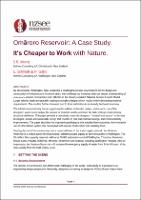Omāroro Reservoir: A Case Study. It’s Cheaper to Work with Nature

Download
Date
2024-04-09Authors
Moniz, Safia
Gaby, Phil
Schmidt, Lars
Metadata
Show full item recordAbstract
By all accounts, Wellington, New Zealand is a challenging seismic environment for the design and construction of infrastructure. In recent years, this challenge has increased with our deeper understanding of Aotearoa’s seismic environment, and reflected in the recently updated National Seismic Hazard Model. Larger seismic loads are typically leading to complex designs which result in more demanding material requirements. The result is further increased cost to local authorities in an already burdened economy.
The infrastructure industry has an urgent need to address embedded carbon, and as such, one of the designers’ goals was to reduce the amount of material used to construct the tank without compromising structural resilience. This paper presents a case study where the designers “worked with nature” to develop an elegant, simple and sustainable design that resulted in cost and material savings, and constructability improvements. The paper describes the engineering philosophy that enabled these outcomes: the innovative use of a foundation system that cooperated with seismic loads rather than resisting them.
Nearing the end of its construction, and a recent addition to the water supply network, the Omāroro Reservoir is a critical piece of infrastructure, bolstering water supply to several suburbs in Wellington. The 35 million litre capacity reservoir will serve 70,000 residents in central Wellington, Thorndon, Newtown, Mount Cook, Hataitai, Kilbirnie, Miramar, Strathmore and Seatoun including Wellington Hospital. Also of importance, the Omāroro Reservoir will increase the emergency supply of water from 24 to 48 hours’ if the main supply from the Hutt Valley is cut.
